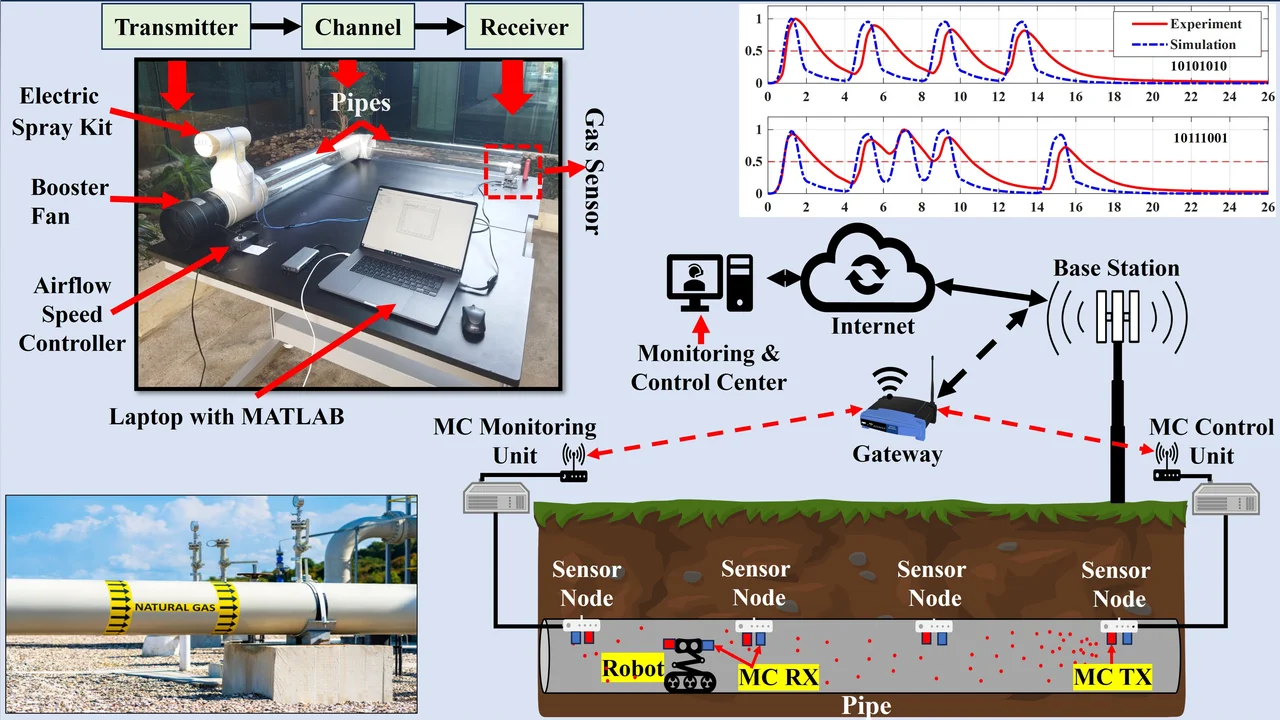
KAUST researchers propose a novel solution for IoT-based monitoring and inspection in harsh pipeline environments
First proposed macroscale application of molecular communication for IoT-based pipeline inspection and monitoring applications verified using a computational model and an experimental testbed.
About
Dr. Muneer Alzubi and Prof. Mohamed-Slim Alouini proposed a novel communication system that could impact the way we monitor and inspect critical pipeline infrastructure. Their work, detailed in a newly published paper in the IEEE Open Journal of the Communications Society, addresses a fundamental challenge in pipeline networks: The failure of traditional wireless signals in buried metal pipeline environments. Watch a detailed demo video of the developed system here: https://www.youtube.com/watch?v=M3A9NVXkoEM
The research introduces a Macroscale Molecular Communication (MC) system, an innovative approach that uses chemical signals instead of radio waves to transmit data. Inspired by biological systems, this method utilizes a volatile organic compound (VOC) as an information carrier, thereby creating a communication link that conventional wireless technology struggles to achieve in such environments.
Pipelines for water, oil, and gas are often buried underground. Pipeline networks require regular inspection, monitoring, and maintenance for various defects like cracks, corrosion, and leaks, while monitoring fluid parameters like quality, consumption, pressure, flow, and temperature. While IoT sensor nodes and inspection robots are deployed for monitoring and inspection, their wireless links suffer from severe attenuation. This research directly tackles this problem, proposing MC as a viable alternative for radio communication between sensor nodes inside pipes and between inspection robots/sensor nodes and external monitoring/control units.
"Buried pipeline networks are filled with various surrounding obstructive materials that highly disrupt and attenuate standard wireless communication," said Dr. Muneer Alzubi. "We looked at biological systems in nature for a solution. Molecular communication is a fundamentally different system that inherently uses molecules rather than electromagnetic waves."
The team not only developed a comprehensive mathematical model to characterize the proposed MC system but also built a functional experimental testbed to validate their theory. They successfully demonstrated the feasibility of the system by transmitting and accurately reconstructing binary data sequences using pulses of VOC molecules.
Key findings from the study include:
- The successful transmission and reception of digital information using molecular signals.
- The significant impact of system parameters (such as airflow velocity, VOC release rate, and emission duration) on communication performance, including bit error rate (BER) and data rate.
- A clear pathway for optimizing these parameters to create robust and efficient molecular data links.
"This work serves as a starting proof-of-concept," said Prof. Mohamed-Slim Alouini. "It is the essential first step in exploring a new domain of connectivity for industrial IoT. Molecular communication could pave the way for more resilient and reliable monitoring of the critical infrastructure that underpins modern society, ultimately preventing leaks and ensuring public safety."
The authors believe this work will open new avenues for research in non-conventional communication systems and their application in harsh industrial environments. In addition, this project establishes a foundation and starting point for researchers to further advance the proposed system.
More details about this project can be found in the following published paper:
Muneer M Al-Zubi & Mohamed-Slim Alouini, “Macroscale Molecular Communication in IoT-based Pipeline Inspection and Monitoring Applications: Preliminary Experiment and Mathematical Model”, IEEE Open Journal of the Communications Society, 2025.

